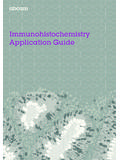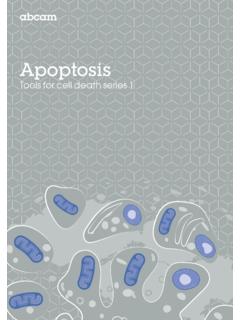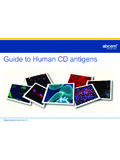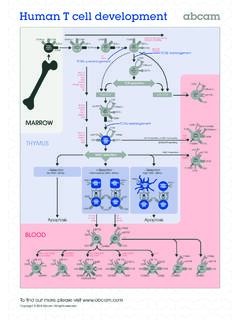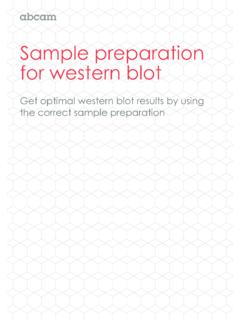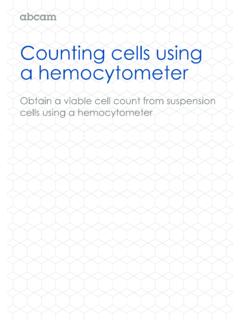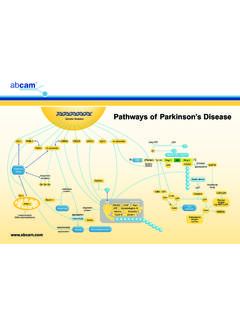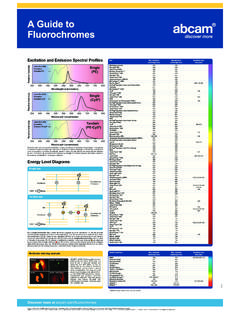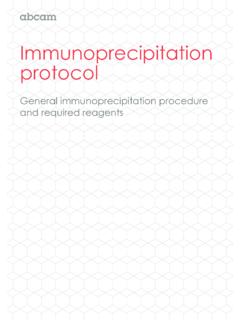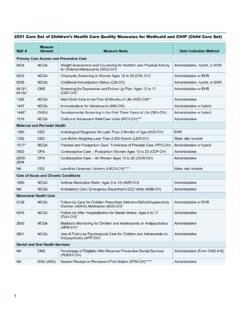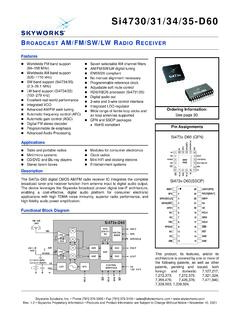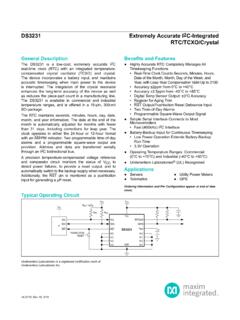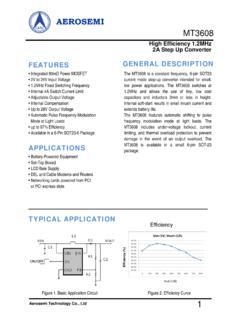Transcription of A Beginner’s Guide to ChIP
1 A Beginner s Guide to chip ? ..3 When to chip ? ..3 Introduction to ChromatinWhat chip is right for me? ..6 What do I do with my DNA to Get Data? ..6 Variations of chip ..7 chip : Getting StartedHow to choose an antibody for chip ..8 How to validate an antibody for chip ..9 Controls ..10 Optimizing chip experiments ..11 Troubleshooting ..14 Protocols AppendixCross-linking Chromatin Immunoprecipitation (X- chip ) Protocol Overview ..16 Cross-linking and Cell Harvesting ..18 Sonication ..18 Determination of DNA concentration ..19 Immunoprecipitation ..19 Elution and reverse cross-links ..19 chip using yeast samples ..20 Chromatin preparation from tissues for chip ..21 chip using plant samples - Arabidopsis ..22 Technical helpOnline resources at Abcam ..26 Product datasheet Guide ..26 Online protocols.
2 27 Online poster library ..27 Ordering and contact detailsContact details ..28 Local offices and distributors ..29 Ordering and contact details ..30 Abcam s terms and conditions ..313 PrefaceThe purpose of this book is to demonstrate the powerful tool of Chromatin Immunoprecipitation ( chip ) and how it can be easilyadapted or incorporated into your own research. Within these pages you will find an overview of chip , suggested protocols andtroubleshooting tips as well as contact details for scientific support should a question come to chip ? chip is a tool that has unlocked the mysteries of chromatin and revolutionized our understanding of the science behind it. TheChIP technique can be used in any area of research to further elucidate gene function and regulation in their native to chip ? chip is a technique that may sound intimidating, but with the right tools can certainly be mastered.
3 The principle of chip is simple:the selective enrichment of a chromatin fraction containing a specific antigen. Antibodies that recognize a protein or proteinmodification of interest can be used to determine the relative abundance of that antigen at one or more locations in the genomein vivo. chip is extremely versatile; it may be used to compare the enrichment of a protein/protein modification at different loci(Figure 1a), to map a protein/protein modification across a locus of interest (Figure 1b ) or to quantify a protein/protein modificationat an inducible gene over a time course. Basically, if you re looking to observe your protein of interest and its interactions with thegenome in its natural state chip is a great choice. Figure performed with an antibody specific for Histone H3 acetylated at K9 (ab4441).
4 The immunoprecipitated DNA was analyzedwith primers and probes for active (GAPDH, RPL30, ALDOA) and inactive (MYO-D, SERPINA, GAD1) loci by real-time PCR. Theresults show that Histone H3 is acetylated at K9 on actively transcribed Service Tel: Europe+44-(0)1223-696000 | Hong Kong(852)-2603-6823 Japan+81-(0)-3-6805-8450 | (Toll free: 1-888-77-ABCAM)PrefaceControl antibodies for transcriptionally active genesTri-methylation of Histone H3 at lysine 4 and acetylation of Histone H3 at lysine 9 are hallmarks oftranscriptionally active genes. Not only do antibodies to these histone modifications serve as useful reagentsin checking the transcriptional activity at a locus of interest, they also can be used as good controls to ensurethat the chip experiment is working. Try:Mouse monoclonal [mAbcam1012] to Histone H3 (tri methyl K4) chip Grade ab1012 Rabbit polyclonal to Histone H3 (acetyl K9) chip Grade ab44414 Figure performed with an antibody specific for the RNA polymerase II CTD repeat phosphorylated at S5 (ab5131).
5 Theimmunoprecipitated DNA was analyzed with primers and probes for the active GAPDH locus (promoter proximal), the inactiveAFM and F8 loci and primers across the active -Actin gene. RNA polymerase II CTD phosphorylated at S5 is enriched close tothe promoters of the active GAPDH and -Actin genes (1), the signal decreases within the -Actin gene (2) and gets very lowclose to the 3 end (3).Scientific to ChromatinBefore we begin describing how to actually doChIP, it helps to have some background on chromatin and where this techniqueoriginated. Structure and function of chromatinIn eukaryotes DNA is found in vivoin complex with proteins and RNA. It is divided between heterochromatin (highly condensed)and euchromatin (less extended). The major components of chromatin are DNA and histone proteins, although many otherchromosomal proteins have prominent roles too.
6 The fundamental unit of chromatin is the nucleosome, which consists of 2 copieseach of H2A, H2B, H3 and H4 histones, and approximately 147 bp of DNA wrapped almost two times around the wraps around histone proteins to form nucleosomes; these in turn couple to become the chromatin function of chromatin is to package DNA to enable it to fit in the cell, strengthen DNA to assist with mitosis and meiosis, andserve as a mechanism to control gene expression, DNA repair, and DNA replication. Histone proteins play an important role inthe regulation of these processes. A large number of residues found on the histones can be covalently modified with chemicalgroups by processes such as acetylation, methylation, phosphorylation, ubiquitylation, sumoylation, ADP ribosylation anddeimination (Kouzarides et al, 2007).
7 Furthermore, cis-trans proline isomerisation while not strictly a modification results in aconformational change (Nelson et al, 2006). These modifications function either by disrupting chromatin contacts or by affectingthe recruitment of non-histone proteins to chromatin (Kouzarides et al, 2007). A number of enzymes have been identified whichcatalyze the addition of these modifications to histone proteins. HistoryThe technique now referred to as chip has been continually refined since the seminal publications in the 1980 s by Gilmour andcolleagues. They demonstrated an association of RNA polymerase II and topoisomerase I with active genes in Drosophila cells(Gilmour and Lis, 1985; Gilmour et al., 1986). The first account of an antibody against a histone modification being used in ChIPwas in 1988 by Hebbes et al.
8 An antibody recognizing N-acetyl-lysine was used to immunoprecipitate nucleosomes containingacetylated histones from 15-day-old chicken erythrocyte nuclei. The precipitated chromatin was then probed with -globin andovalbumin DNA sequences. Specific enrichment of the -globin locus, but not the ovalbumin gene, demonstrated a link betweenhistone acetylation and an active transcriptional state in vivo(Hebbes et al., 1988). DNA wrapped around histone octamers to form nucleosomes DNA Nucleosomes compacted into a chromatin fibre Customer Service Tel: Europe+44-(0)1223-696000 | Hong Kong(852)-2603-6823 Japan+81-(0)-3-6805-8450 | (Toll free: 1-888-77-ABCAM)Introduction to Chromatin6 What chip is right for me?Native chip (N- chip ) and cross-linking chip (X- chip )There are two general procedures for carrying out chip experiments, native chip (N- chip ) and cross-linking chip (X- chip ).
9 Thechoice between N- chip and X- chip is dependent on your experimental aims and the starting material used:(i) N- chip :Native chromatin is used as the substrate, which means that proteins are not cross-linked to the DNA. Fragmentationof the chromatin is achieved by micrococcal nuclease digestion, resulting in a nucleosome based resolution. N- chip is restrictedto proteins that are very tightly associated with chromatin, typically limiting this type of chip to histones and their modifications(O Neill and Turner, 2003). (ii) X- chip :Proteins are cross-linked to the DNA. Cross-linking is typically achieved using formaldehyde and chromatin isfragmented by sonication, creating random fragments. As the proteins are cross-linked to the DNA a broad range of chromatinassociated factors can be analyzed using this technique.
10 Detailed chip protocols can be found in the Appendix (see page 16). Figure overview of the N- chip and X- chip protocols. What do I do with my DNA to get Data?Analysis of the isolated DNA can be performed in a number of ways and allows one to analyze the enrichment of the target. Thecombination of chip with whole genome analyses such as microarray ( chip - chip ) and next generation sequencing ( chip -seq)has permitted the mapping of a protein or a protein modification over the entire genome. Alternatively PCR analyses of a specificregion may be QuantificationEnrichment of a target is not solely dependent on the quantity of antigen associated with it. Immunoprecipitation will be affectedby the accessibility of that antigen in that particular chromatin environment, the affinity of the antibody and the precise conditionsof the immunoprecipitation.
